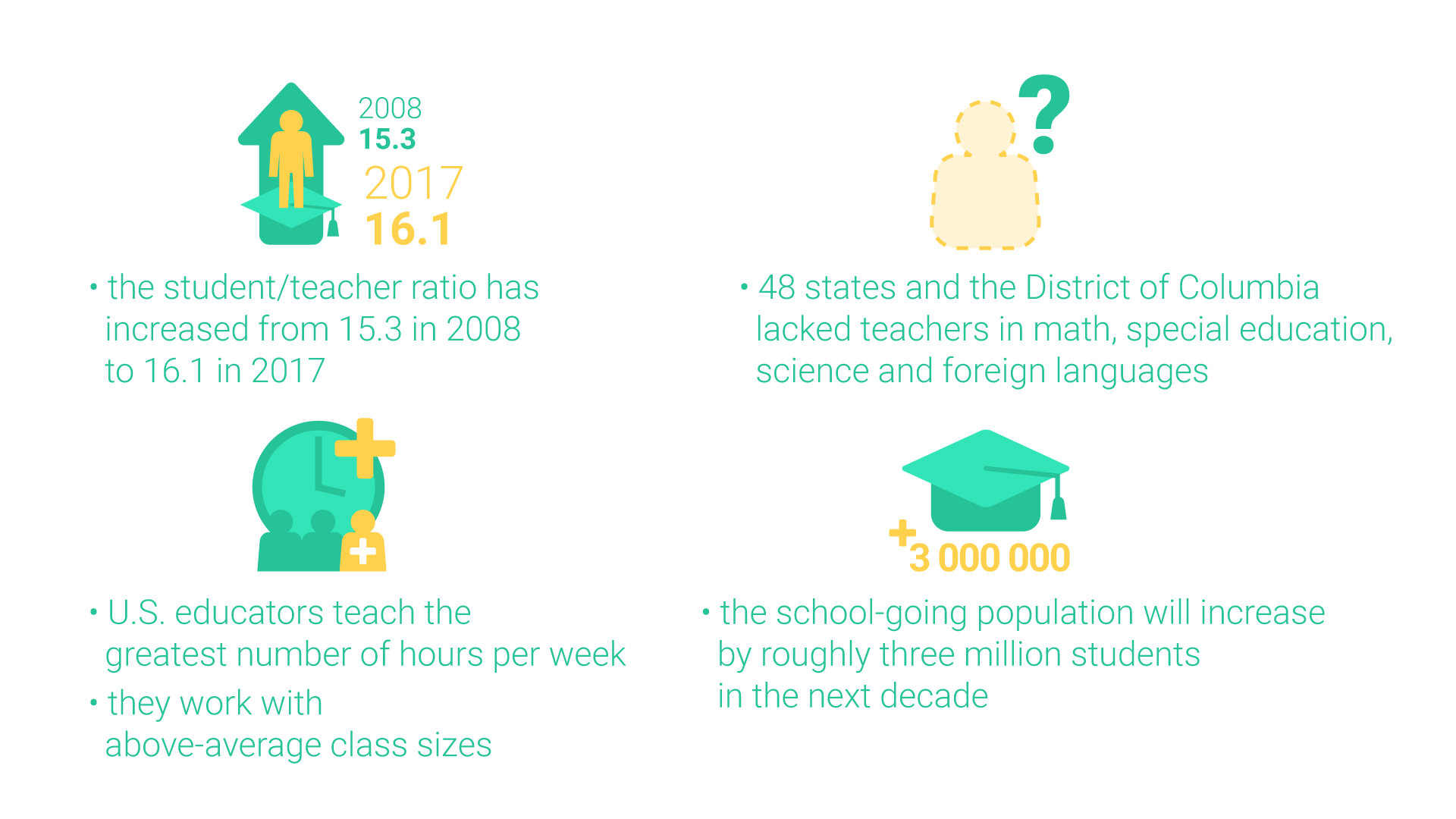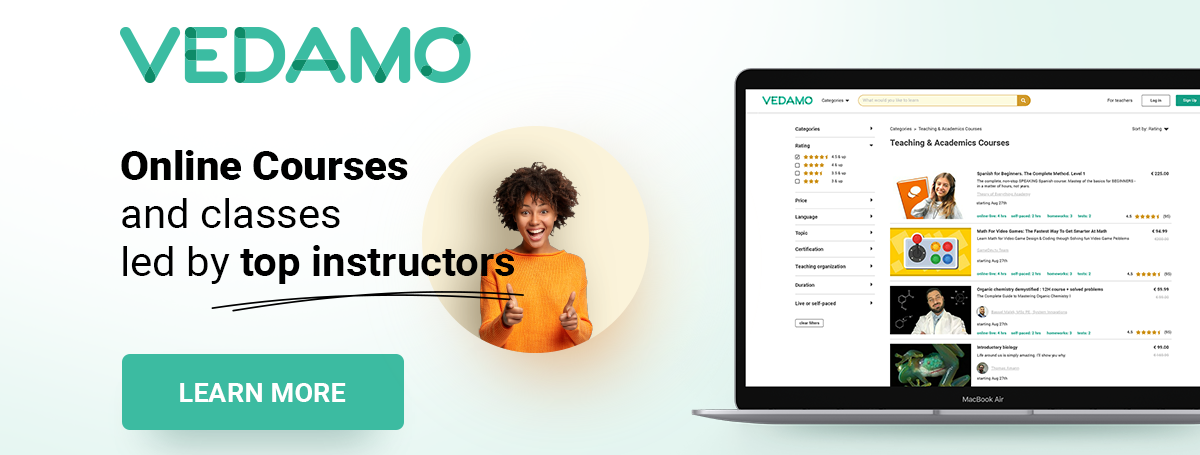Тhe most common type of blended learning is the combination of traditional face-to-face classroom teaching with self-paced online instruction, typically using a learning management system. When we have limited resources, the training is primarily delivered online with only a few options for face-to-face interactions. This might lead to reduced learner motivation and retention rates. Blended online training can address these challenges and offer quality teaching and learning with fewer resources. It combines self-paced online instruction with live online teaching in a virtual classroom as a substitute for traditional classroom instruction.
Teacher shortages are serious concerns in many places around the world. In the US, teacher demand increased sharply after 2007 due to changes in student enrollment, shifts in pupil-teacher ratios, and most significantly, high levels of teacher attrition. Pupil-teacher ratios increased from 15.3 in 2008 to 16.1 in 2017 – it would require hiring an additional 145,000 teachers to reduce these ratios. A recent OECD survey reported that educators in the US teach the greatest number of hours per week and have above-average class sizes.
The Learning Policy Institute reported that public schools nationwide don’t have enough teachers – 48 states and the District of Columbia lacked teachers in math, special education, science, and foreign languages. At the same time, the National Center for Education Statistics (NCES) predicts the school-going population will increase by roughly three million students in the next decade.

Physical schools and the providers of traditional training are limited in their ability to reach the growing number of students due to their resources – mainly teachers and facilities. To address this issue they are implementing blended learning. In most cases blended learning combines asynchronous self-paced online learning with traditional teaching. What matters here is finding the right balance between the two teaching modalities. When there are still limited resources, most of the training is delivered asynchronously as self-paced online courses, which creates another challenge – the retention rate.
Studies report that on average only 25% of learners complete their self-paced courses in comparison to 75% when there is live interaction.

Among the key reasons for the low retention rate in self-paced courses is the challenge to keep students motivated and engaged when there are limited options for live interaction, immediate feedback, and personal support.
What can be done in these situations? When we have a limited budget and resources, we could implement blended online training. This could be added to self-paced courses that would allow for real-time synchronous online classes with videoconferencing.
But is every video-conferencing tool capable of ensuring a high quality of teaching and learning?
The tools designed for personal and business communication might not fit in the educational context. Usually they lack tools for including a variety of content presentation and learning activities, as well as collaborative activities.
When you enter a traditional classroom, it is highly possible to see bored students who are gazing distractedly while scrolling through their smartphones and not paying attention to the lesson. A 2015 study by Microsoft reported that, since 2000, the average attention span dropped from twelve to eight seconds. This may be a side effect of the increasingly digital lifestyle. At the same time, according to the International Listening Association, 45% of a student’s day is spent listening, and students are expected to acquire 85% of their knowledge through listening.

How can teachers address this issue – by using a variety of teaching methods and activities that actively engage the students. When the content is presented in different formats, it is easier for the learners to pay attention after the activity has ended. To ensure quality online teaching and learning, the virtual environment should provide the teacher with opportunities to do it.
VEDAMO’s Virtual Classroom is specifically designed for education and can be a great substitute to traditional teaching. When combined with a dedicated learning management system, it gives new opportunities to teaching organizations to be more flexible, to reach more students with the same or fewer resources, and to engage them in a variety of activities.
VEDAMO’s Virtual Classroom has many features for interactivity and collaboration. Here are the key ones:
- Videoconferencing – You can see and hear up to 25 participants simultaneously during the online session.
- Interactive online whiteboard – You can share various types of teaching materials and engage your participants in collaborative activities using the tools for creating, editing, and presenting learning content.
- Media player – You can use various multimedia materials and share YouTube videos during your live online classes.
- Breakout rooms – You can conduct small group activities and assign individual tasks in separate work spaces.
- Screen-sharing – You can demonstrate external software or multimedia applications by sharing your screen with the participants.
- Session templates – You can create and reuse content templates, which save all learning materials arranged by you in the virtual classroom.
- Session recordings – You can watch past sessions using interactive playback to analyze and improve your online classes.
- Teacher control – You can easily moderate your online sessions – teachers have full control over the participants’ actions and interfaces.
Blended online training, or the opportunity for live interaction without any physical constraints as a part of your self-paced courses, can bring a number of benefits to all participants involved in the teaching and learning process.
Teaching organizations can:
- Reach more students online with fewer resources
- Save on overhead, facilities, logistics and operational costs, and automate routine tasks
- Conduct office hours, follow-up sessions, and consultations more easily
The teachers can:
- Deliver interactive and engaging content
- Have full control over the participants’ actions
- Save a lot of prep time by creating and reusing their lesson templates
The students have:
- Flexible schedules and the ability to attend the session from anywhere
- An increased level of motivation as a result of using modern technology, interactivity, immediate feedback, and personal support in the learning process
- Access to a safe and secure environment
What to learn more? Book your free live demo and see how easy online teaching can be.

